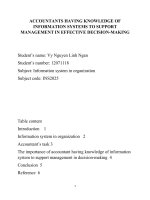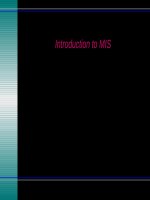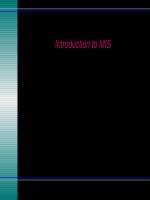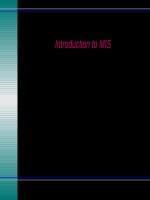Lesson Information systems management
Bạn đang xem bản rút gọn của tài liệu. Xem và tải ngay bản đầy đủ của tài liệu tại đây (680.53 KB, 27 trang )
Lecture 10: Information Systems
Management
Study questions
Q1: What are the functions and organization
of the IS department?
Q2: How do organizations plan the use of IS?
Q3 What tasks are necessary for managing
computing infrastructure?
Q4 What tasks are necessary for managing
enterprise applications?
Q5: What are the advantages and
disadvantages of outsourcing?
Q6: What are your user rights and
responsibilities?
BUSINESS INFORMATION TECHNOLOGY
2
3
Q1: What are the functions
and organization of the IS
department?
BUSINESS INFORMATION TECHNOLOGY
Functions of the IS Department?
►
Plan use of IS to accomplish
organizational goals and strategy.
►
Manage outsourcing relationships.
►
Protect information assets.
►
Develop, operate, and maintain the
organization’s computing
infrastructure.
►
Develop, operate, and maintain
applications.
BUSINESS INFORMATION TECHNOLOGY
4
How Is the IS Department
Organized?
Source: Textbook [1], page 375
BUSINESS INFORMATION TECHNOLOGY
5
How Is the IT Department Organized?
►
Chief Information Officer (CIO)
▪
▪
►
Technology office
▪
▪
►
Principal manager
Reports to CEO, COO, or CFO
Head: Chief Technology Officer (CTO)
Investigates new information systems
technologies for possible application at
organization
Operations
▪
Manages computing infrastructure
BUSINESS INFORMATION TECHNOLOGY
6
How Is the IT Department Organized?
►
Development
▪
▪
►
Outsourcing relations
▪
►
Manages process of creating new
information systems
Maintains existing system
Handles affairs with outsourced systems
Data administration staff functions
▪
Establishes data standards and data
management practices and policies
BUSINESS INFORMATION TECHNOLOGY
7
8
Q2: How do organizations
plan the use of IS?
BUSINESS INFORMATION TECHNOLOGY
Planning the Use of IS?
Source: Textbook [1], page 378
BUSINESS INFORMATION TECHNOLOGY
9
Align information systems with
organisational strategy
►
Maintaining alignment: a continuing
process
►
strategies change
►
Organization changes: merge, expand,
shrink
BUSINESS INFORMATION TECHNOLOGY
10
Communicate issues to the
executive group
►
CIO provides the IS perspective during
discussions of problem solutions,
proposals and new initiatives.
►
For example:
►
when considering a merger need to
consider integration of ISs in the merged
entities during evaluation of merger
opportunity.
BUSINESS INFORMATION TECHNOLOGY
11
Develop priorities and enforce them
within the IS department
►
CIO must ensure that priorities consistent with
overall organisational strategy are developed
and communicated to IS department.
►
Must also ensure that IS department evaluates
proposals and projects for using new
technology in light of those communicated
priorities.
BUSINESS INFORMATION TECHNOLOGY
12
Sponsor the steering committee
Steering committee
►
A group of senior managers from major
business functions, which works with the CIO
to set IS priorities and decide among major IS
projects and alternatives
►
Provides a forum where IS personnel can
discuss potential IS initiatives and directions
with the user community
►
Provides a forum where users may express
their needs, frustrations and other issues they
may have with the IS department.
BUSINESS INFORMATION TECHNOLOGY
13
14
Q3 What tasks are necessary
for managing computing
infrastructure?
BUSINESS INFORMATION TECHNOLOGY
Managing computing infrastructure
►
Align Infrastructure Design with
Organizational Structure
►
Example:
Source: Textbook
[1], page 382
BUSINESS INFORMATION TECHNOLOGY
15
Managing computing infrastructure?
►
Create, Operate, and Maintain
Computing Infrastructure
►
►
►
►
►
►
infrastructure for end-user computing.
Networks
data centers, data warehouses, and data
marts.
Establish Technology and Product
Standards
Track Problems and Monitor Resolutions
Manage Computing Infrastructure Staff
BUSINESS INFORMATION TECHNOLOGY
16
17
Q4 What Tasks Are Necessary
for Managing Enterprise
Applications?
BUSINESS INFORMATION TECHNOLOGY
Managing Enterprise Applications
►
Develop New Applications
►
Maintain (Legacy) Systems
►
A legacy information system is one that has
outdated technologies and techniques but is still
used, despite its age.
►
Adapting Systems to Changing Requirements
►
Tracking User Problems and Monitoring Fixes
►
Integrate Enterprise Applications
BUSINESS INFORMATION TECHNOLOGY
18
Managing Enterprise Applications
►
►
Manage Development Staff
Administer Data
►
Define Data Standards
►
►
►
►
Data standards are definitions, or metadata, for data
items shared across the organization. They describe the
name, official definition, usage, relationship to other
data items, processing restrictions, version, security
restrictions, format, and other features of data items that
are shared across the organization.
Maintain the Data Dictionary
Define Data Policies
Plan for Disaster Recovery
BUSINESS INFORMATION TECHNOLOGY
19
20
Q5 – What are the advantages
and disadvantages of
outsourcing?
BUSINESS INFORMATION TECHNOLOGY
Advantages of outsourcing
Popular Reasons for
Outsourcing IS
Services
Source: Textbook [1], page 390
BUSINESS INFORMATION TECHNOLOGY
21
Disadvantages of outsourcing
Outsourcing Risks
Source: Textbook [1], page 393
BUSINESS INFORMATION TECHNOLOGY
22
23
Q6 What Are Your User Rights
and Responsibilities?
BUSINESS INFORMATION TECHNOLOGY
24
User Rights
Source: Textbook [1], page 395
BUSINESS INFORMATION TECHNOLOGY
25
User Responsibilities
Source: Textbook [1], page 395
BUSINESS INFORMATION TECHNOLOGY









